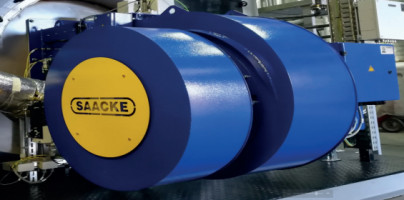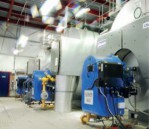Better life energy
Published: 14 October, 2020
PWE spoke to Phil Kemp, general manager at SAACKE Combustion Services Ltd, which is celebrating its 60th year of business in the UK, to discuss the importance of low NOx combustion, the future of Hydrogen Boilers within UK manufacturing, and the importance of servicing combustion equipment.
NOx gases contribute to the formation of smog and acid rain, as well as affecting ozone. The adverse health effects from these nitrogen oxides can affect the lungs and heighten the risk of respiratory conditions including asthma. Therefore it is in everyone’s interest to reduce harmful emissions. Phil Kemp, general manager at SAACKE Combustion Services, comments that in order to protect the environment, we must achieve much lower emission values for the combustion of fossil fuels than those prescribed by law: “If we use hydrogen instead of fossil fuels, the NOx formation still takes place (even higher NOx than with firing natural gas, if one does not take care!), therefore always, we should look to (ultra) low NOx combustion.”
He explains that the most significant factors are the flame temperature and the quantity of nitrogen in the fuel influencing NOx formation. Other factors that have an influence being the excess air level and combustion air temperature, not forgetting a poor combustion set up where inexperienced service providers may get involved. Kemp adds that “burner construction is far more complicated these days to achieve the latest emission legislation therefore requiring a competent service provider.”
There are several different legislations currently in place with regards NOx emissions, these are dependent on the size of the plant:
Medium Combustion Plant Directive
Directive (EU) 2015/2193 on medium combustion plants (MCPD): The MCPD regulates emissions of sulphur dioxide, nitrogen oxides and dust from the combustion of fuels in plants with a rated thermal input between 1 and 50 MW thermal. The emission limit values set in the MCP Directive apply from 20th December 2018, this for new plants and then by the 1st January 2025 (over 5 MW) or 1st January 2030 (1 to 5MW) for existing plants. The limits for existing plant are higher than those for new plant.
Industrial Emissions Directive IED (2010/75/EU)
Directive 2010/75/EU on industrial emissions (IED): This establishes the main principles for permitting and control of large industrial installations based on an integrated approach and the application of Best Available Techniques (BAT). BAT is the most effective techniques to achieve a high level of environmental protection, considering the costs and benefits.
The UK government will make secondary legislation to ensure the existing BAT conclusions continue to have effect in UK law after we leave the EU on the 1st January 2021, this to provide powers to adopt future BAT conclusions in the UK and ensure the devolved administrations maintain powers to determine BAT through their regulatory regimes.
Kemp highlights that operators must demonstrate compliance for each individual combustion plant by carrying out monitoring as specified in the permit to the required method: “Monitoring will normally be required for each unit unless conditioned otherwise in a bespoke permit. We can say that the costs for emissions will constantly increase, the polluter pays. The measurement equipment itself has been industry-standard for many years.”
Kemp believes that current service procedures used on industrial plant, can be conducted by reputable service companies to carry out the monitoring required for MCPD on plant up to 20MW. In practice, the main methods used for the measurement of NOx are infrared, chemiluminescence and electrochemical.
Reducing NOx
In general, according to Kemp, there are two different technical approaches to reducing NOx emissions: primary measures, based on a modified combustion management system (low NOx technology) and secondary measures, which are downstream of the combustion system (flue gas cleaning). Secondary measures are associated with high investment costs and operating costs, so many operators will prefer the low NOx technology.
He adds that NOx emissions can be reduced by: reducing peak combustion temperature, reducing residence time at the peak temperature, chemical reduction of NOx during the combustion process, and/or reducing nitrogen in the combustion process.
These primary NOx reduction methods frequently involve extra cost or lower combustion efficiency, so NOx measurements are essential for the optimisation of engine/boiler efficiency. Secondary NOx reduction measures are possible by either chemical reduction or sorption/neutralisation. Naturally, the effects of these measures also require accurate emissions monitoring and control.
Hydrogen
Although the NOx emissions in hydrogen operation are about 2.5 to 3 times higher than NOx emissions in natural gas operation, Kemp says that hydrogen will play a crucial role in the energy mix of the future. The development of green hydrogen production will also be key to enabling the UK to achieve its net zero ambitions. There are several green hydrogen production plants across the North of England and Scotland.
Kemp explains that the extremely rapid combustion reaction of the hydrogen and its higher adiabatic combustion temperature, which is accompanied by larger temperature peaks in a smaller space, provides for increased thermal NOx formation. Consequently, a hydrogen flame is also shorter than a comparable natural gas flame and there is a higher thermal load on the front part of the combustion chamber. The NOx can be reduced to natural gas levels by Flue Gas Recirculation (FGR).
Kemp adds that the world now understands hydrogen’s potential as a resource: “The fact that there are little, or no emissions will help to achieve the climate goals that are being introduced.
Hydrogen does not produce CO2 emissions by combustion, it is not poisonous, and has wide flammability limits, therefore it is easier to maintain a flame, and consequently reduces the emission of greenhouse gases.”
Kemp comments that SAACKE is committed to efficient and low-emission energy generation using all its knowledge and experience. The company calmly faces increasing proportions of H2 in natural gas - all gas burners from SAACKE allow up to 20% hydrogen in natural gas ‒ and are therefore sustainable. Clean and efficient usage of up to 100% pure hydrogen is available.
Maintenance
However in order to maintain efficiency, reliability and safety, Kemp emphasises the importance of maintaining plants and systems required for production and heat generation to the highest standard cannot be underestimated: “Ultimately, the reliable condition and efficient performance of the equipment is the basis for smooth execution of all industrial processes and extends the service life of the plant.”
He highlights that anyone who seeks to benefit from higher planning reliability, lower management expenses and regular measures to improve energy efficiency needs a reliable and experienced partner in combustion technology to provide support. He comments that SAACKE has been a responsible partner for maintaining combustion technologies for decades: “Our service is not standardised, because no two plants are alike; instead, we provide a customised service contract that we coordinate together with the customer, giving the greatest possible amount of freedom to ensure we provide the services needed.” He adds that the key issues in regard to servicing are “planning, reliability, efficiency, flexibility, and experience in energy technology.”
SAACKE Combustion Services provides service maintenance contracts covering burners, controls, and complete boiler plant.
Conclusion
Kemp concludes that the company success in its 60th year within the UK, is understanding its customers, which he says: “is so important to us and being able to adapt to the market conditions with new technologies. Characterised by decades of engineering know-how, extensive system knowledge and a progressive technical mindset, the quality of our Customer Service Solutions is our key distinguishing feature. This quality involves both our certified original spare parts as well as the forward-thinking service personnel who are also happy to provide advice.”
For further information about any of the topics mentioned in this article please contact SAACKE at:
Tel. +44 (0)23 92 333900
*****************
The SAACKE TEMINOX GL, a further development of the established burner family, meets all the necessary criteria for a future-proof, modern combustion system. The lowest emissions achieved are below 30 mg/m3 NOx. In both the monoblock and the duoblock versions, the TEMINOX GL burns a wide range of standard fuels and special gases efficiently and with low CO and residual oxygen content in the flue gas.
Burner capacity 3-28 MW
For the larger capacity boilers, the company has its ultra-low NOx burner series ATONOX, which also can reach < 30 mg/m3 NOx. As an innovative development in the domain of low NOx gas burners, the ATONOX from SAACKE heralds the start of a new generation. The ATONOX sets new standards with regard to environmental protection and consistently operates below stringent emission limits – even without secondary measures such as external recirculation of flue gases. It is therefore also in line with the strict current Chinese emission limits and the EU emission limits for gas-fired new and existing plants that will come into force in 2021 due to the Best Available Technology requirements.
***************************






 The CEA reports one of the single most important directives for many years in the combustion industry is about to become EU law and will soon be transposed into UK law. Owners or operators of any combustion plant with a thermal input of between 1MW and 50MW will be affected. This means anyone with a boiler generating around 1.5 tonnes of steam or more, or using a CHP or diesel generator of around 500kVA or more, will need to know about this directive. There are estimated to be at least 15,000 such plants in the UK alone.
The CEA reports one of the single most important directives for many years in the combustion industry is about to become EU law and will soon be transposed into UK law. Owners or operators of any combustion plant with a thermal input of between 1MW and 50MW will be affected. This means anyone with a boiler generating around 1.5 tonnes of steam or more, or using a CHP or diesel generator of around 500kVA or more, will need to know about this directive. There are estimated to be at least 15,000 such plants in the UK alone.
